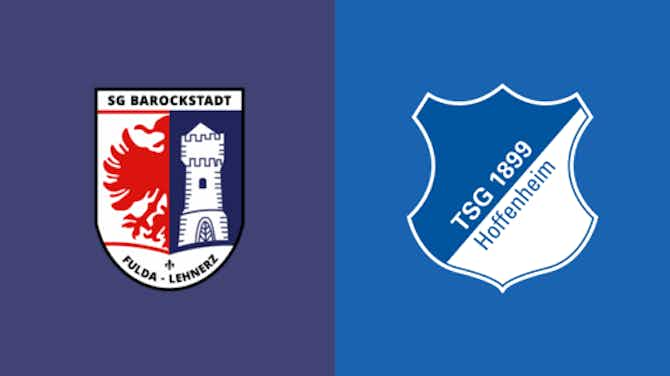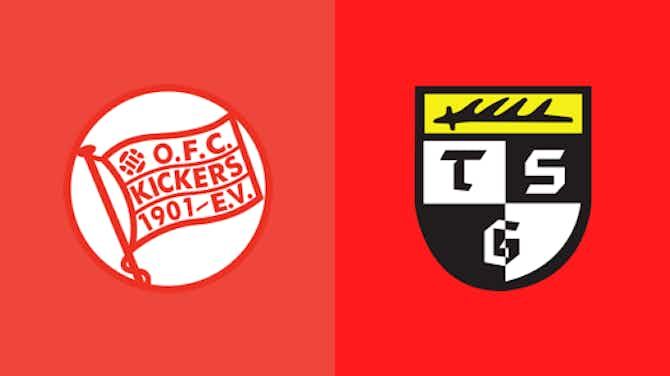Total Football Analysis
·21 April 2020
Tactical Theory: Compactness
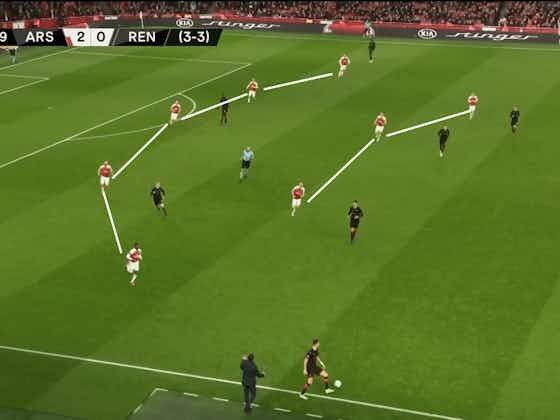
Total Football Analysis
·21 April 2020

The idea of compactness has become a constant when talking about modern football tactics, especially when it comes to chit-chatting about defensive structures and out of possession blocks that most teams use. Even though it is quite a commonly used word, and it is quite simple terminologically, compactness is way more complex in terms of the influence it directly has on the game. Connections between the one side’s players are keys that open up a lot of doors in football, making compactness one of the main elements of the two-way game that we witness today since it affects a lot of different segments and phases during the matches.
The first part of this tactical theory analysis series will break down the main principles of compactness, pointing out the exact meaning of the phrase, along with showing how it influences defending parts of the game, talking about how this concept differs regarding the orientation of teams. Also, I’ll try to examine the benefits and flaws of compactness through plenty of examples from matches, including talk about multiple other tactical terms. In the vol. 2 of this tactical analysis, I’ll break down the influence of compactness on both attacking and transitive phases, as much as about how it effects pressing and counter-pressing access along with all of its flaws.
First of all, I shall define the main topic. Compactness is nowadays often used by coaches and pundits, players, fans, football analysts, and guys who are just passing by the TV when the game is live on air. All of them are, more or less correctly, referring to the structure of one team, lines and bonds between the players that make them look like united, mostly when out of possession.
The truth is that compactness influences the offensive phase of the game as much as it does with defending because links between the players don’t disappear no matter which part of the game is in progress. Mentioned connections are equally important in and out of possession and they matter as much even when the players are poorly bonded. Therefore, the point is that compactness is not only related to defensive actions.
This analysis will focus itself on the talk about defensive compactness since the offensive one is equally important and needs to be examined through a whole new piece. Although there would be some words on the attacking influence, the main idea is to break down the entire concept of the defensive compact game.
Then, what is the definition of this term? Most of the authors – analysts, coaches, and experts that wrote about this topic before me, agree that “compactness” is a space-related concept that highlights the distances between one team’s players. In other words, compactness is the idea of players from one team keeping the biggest possible distance between themselves maintaining links between each other that will keep them in control of the space they occupy and action inside their occupied structure. And that’s the fact no matter the phase of the game.
That means that teams are “compact” when they succeed in creating the well-linked formation that will help them control the pitch, the ball, the opponent, or whichever will allow them to be ready to react in the right moment. The tactical theory sees compactness by teams staying “linked” both horizontally and vertically – keeping their lines in terms of formational lines (defensive line, midfield line, attacking line on the horizontal axis) and in terms of the lines on the vertical axis (defender-midfielder-striker lines).
As I said, the teams can be seen as compact when they manage to create strong bonds between their own players who are on optimal distances from each other retaining the quality of connections with their teammates and controlling the space, both individually and as a unit.
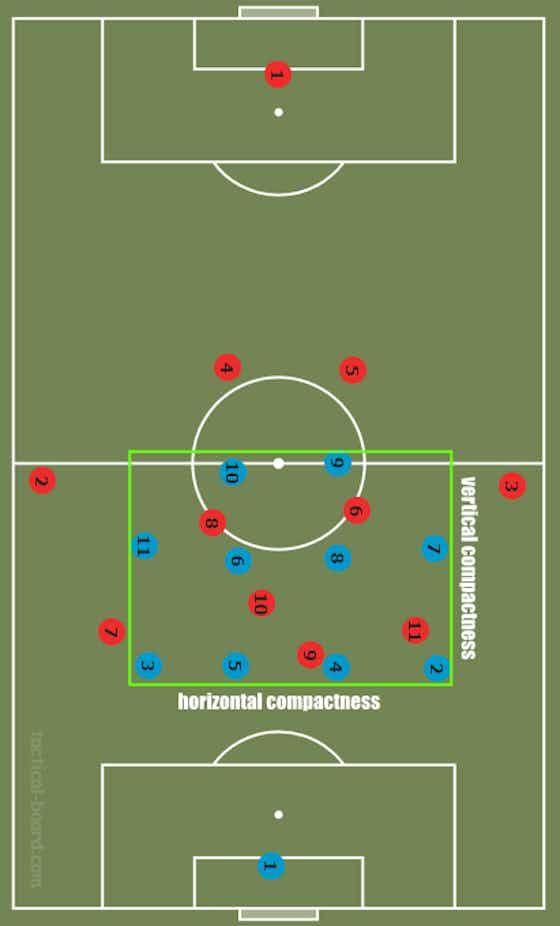
In the picture above, it is very roughly shown how compact sides position in the out-of-possession phases of the game. The distances between the players of the Blue team are the biggest they can get in order to keep their shape stabile and close down the potential passing lanes, progressive play, and individual efforts from the opponents. The defending side is compact upon both of the axes and they can maintain the command of the most important areas of the pitch.
Opposite to that are non-compact sides, which will also be presented in an exaggerated manner in order to make it as clear as possible. The stretches between players in this “type” of setups are too wide to be controlled and rivals can easily exploit the gaps between them.
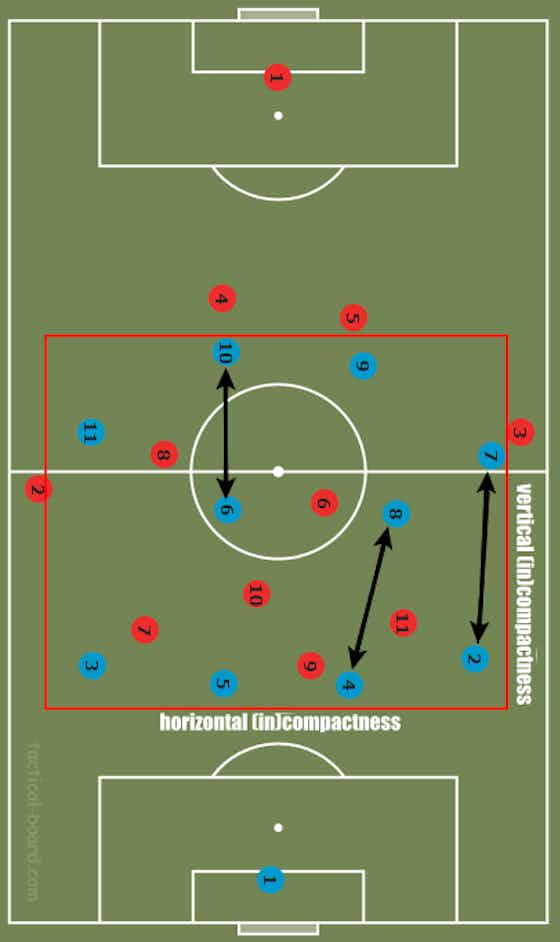
The defending team is now non-compact since the spaces between the lines are spread, so rivals can make themselves comfortable and utilise on the bad formation from their opponents. This setup is short on stability and it cannot secure the space-control for defending team because of plenty of reasons – every player is in charge of a wider area, there is much more room in between, runs from the defenders are longer, etc.
The other thing that is important to be pointed out is that teams can set themselves compact upon one axis, but not on the other. For example, the players can position very good inside horizontal lines, keeping the right stretch, but failing to engage the exacts distance between the lines of the team vertically. Blues in the second picture are more or less well-organised down the horizontal axis, since they are keeping their lines, but they lack verticality in their block since the gaps are really wide and opposition can take advantage of that fact.
Compact attacking is as important as compact defending, but I used defending shapes in the definition segment because they can help you understand compactness more easily, and defence is in our focus.
The basis of the term, and the concept of the game, lays down in the two key ideas – 1. keeping the shape for action/reaction and 2. controlling the space and situation on the field. Both of the ideas are, at first, clearly observed as defensive ones, but either of them is equally related to transitions and attacking phase of the game. Sometimes even more than to the defensive one.
But, coming from the top of the head, compactness has its branches deep in the defending. It allows the teams playing in that manner to be tougher to break through, enabling them access to react in various scenarios. At the same time, the usage of this concept commonly makes them vulnerable in some other zones of the pitch – in those that they willingly leave open since they mark them as the areas with lesser value regarding the momentum on the pitch.
Like I mentioned a couple of times earlier in this tactical analysis, defensive compactness is the gameplan that is oriented to space control through the well-organised out of possession shape of one team. The main idea when defending compactly is to close down the paths of progress for the opposition through the most valuable areas of the pitch, which differ regarding the exact situation happening in the game.
Theoretically, the zone that has the greatest worth is the one in the centre of the pitch – including high and low half-spaces along with the whole length of the central corridor. Teams that focus on being compact in these areas means they are going to play more or less narrowly and to create a great concentration of the players in the inside zones of the pitch. That results with them controlling the “most dangerous” zones for their own goal, disabling midfield penetration, forcing their opponent to circle the block, but at the same time allowing them to be “in control” of the flanks as they are marked as the least important areas.
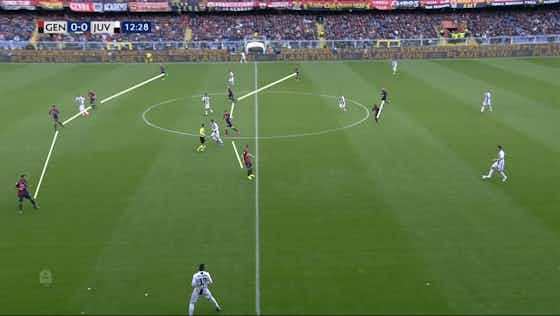
Here we can see a great example of Genoa side from the last season being both horizontally and vertically compact and closing down the midfield options for Juventus. Juve’s midfielders are outnumbered in the central areas of the pitch, and Genoa’s men are positioned very well in reference to opponents, ball and space, making circling and entering flanks the only possibility for the opposition.
The other thing that good organisation of compact blocks guarantee is access to the ball. In the previous picture, the defending team has a good opportunity to anticipate possible pass to the left flank, since they can possibly create a defensive 2 v 1 against wide defender if moving properly. Although there is a lack of pressure on the player with the ball due to Genoa’s concentration on defending the pass towards Juve’s pivotal midfielder, they still are in a good position to react and set up the pressing trap if they continued to move in the right manner. The compactness in this scenario means that they’ve disabled a midfield pass from the opposing side by creating surpluses against their players since all the balls directed to the central areas would result with Genoa’s great possibility to react in numerical superior setups.
Defending in the compact structures is commonly used by today’s biggest teams since it is an important starting point in zonal marking. The characteristics of the concept are closely related to massive individual protection of areas, that are then seen as team-defending of a bigger unit (area of the pitch) created from smaller individual spaces (various zones), also known as zonal coverage. While it can also be used in man-covering defences, the usage of this concept is rarer in these kinds of setups since the motions of defenders then majorly depend on movements of attackers. However, that doesn’t mean that man-marking teams will necessarily lack compactness if their communication and switch-defending are on a high level.
Compactness by its definition requires the longest possible distances between the teammates that can be controlled and won’t reduce the quality of the connections. Those lengths depend on the exact situation on the pitch and on the motions of opponents. The method in which different teams use compact shapes conditions on one side’s orientation when defending. The reference point that they consider as the most valuable shapes their compactness and decides in which areas will they get to be compact, and which ones will they mark as less important. There are four ways to orient a team in these scenarios: 1. ball-oriented compact blocks, 2. opponent-oriented compact blocks, 3. space-oriented compact blocks, 4. option-oriented compact blocks.
Compact defences have better access for reactions than the incompact ones which is related to their good communication and linked-movement inside the structure. As I said, all of the out-of-possession motions are dependent on one of the four reference points, and compact blocks are often using the ball as the main factor of orientation.
The idea behind that concept is to set up your team organised in the area where the ball is, trying to create a defensive overload on that side (most commonly) of the pitch and disabling forward passes through that area. What this concept lacks is the fact that if the ball side is fully engaged with defenders, it means that the opposite one is deserted and opens a lot of room for potential switch passes and isolations out of offensive overload. That can easily make teams vulnerable after fast diagonal balls, but it is surely the thing coaches voluntarily go for trying to win the ball in tighter zones and relying on fast side-to-side transformation from their players.

In the image above, we can see a roughly painted setup of ball-oriented defence. That kind of positioning opens the ball-access for them and guarantees the defensive surplus on the ball-side of the pitch, fully disabling the progressive play down through the midfielders and wide players on the left-hand side of the attack. The thing that makes that risky is the fact that it opens up a circling option for opposition so they could fastly move to the other flank in order to bypass the entire block.
Teams defending this way must count on the fast side-to-side transformation, and need to train it to perfection so they won’t be caught unprepared in scenarios similar to the one shown in the scheme. Ball-orientation is most often used from the “smaller” teams in order to prevent stronger sides of exploiting individual quality in smaller areas, and also by the teams playing against sides that lack horizontality in their attacking compactness.
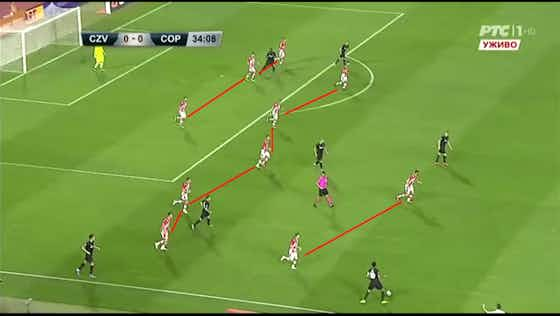
This example comes from the Red Star Belgrade versus Copenhagen UEFA Champions League qualifier from this season. The Serbian side forced the opposition to move the ball to the flank and oriented their whole block towards the ball. Since the ball isn’t in a position to move quickly – looking at the setup of the attackers, who clearly miss out on offensive compactness, along with body-position of the ball carrier – Red Star’s ball-oriented compact shape is successful. They have access to the ball, they’ve closed forward options, while also having enough time to transform if the ball is played backwards in order to circle and sending it to the opposite flank.
With the teams that set themselves better when in possession, the ball-orientation has its flaws since it can be bypassed quickly and could result in dangerous 1 v 1 isolation on the opposide-handed side. Or even worse, in an open position for attackers from which they could go for an attempt on goal.
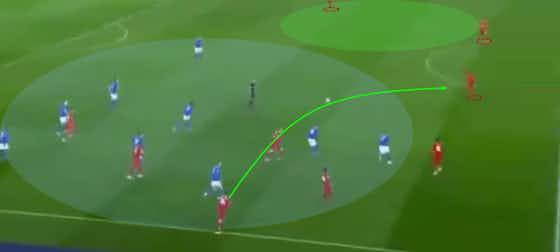
The picture shows us how fast thinking and moving can get the better of ball-oriented blocks. Even though Leicester City looks compact in this situation, they don’t have good horizontal compactness and are too ball-oriented so Liverpool players can bypass them with just one simple throw-in, ending the attack on the right-hand side where they have qualitative and numerical superiority.
That’s the thing – ball-orientation of a “compact” defensive structure can often result in bad horizontality and good verticality but in the restricted area of the pitch. If the team isn’t physically prepared for transformation efforts, it can cause them huge problems and their compactness won’t be of big use for them. But with sides who are well-drilled and “can run”, pointing out the ball as the main focus of their attention can be a useful thing since the vertical progress can be easily disrupted.
When it comes to the second type of compact defending, orientation to the opponent is often seen just as man-marking, but it can be much more than that. As we saw in the example of Genoa, man-orientation of the blocks are often mixed with the idea of zone-control or option-closure.
Compactness that focuses opponents as the main reference point of the organisation is quite intermingled with focus on options since the players are necessarily the only options for one team’s progress besides the potential shots. That being said, compact defences require short distances between teammates and also between players and their direct rivals.
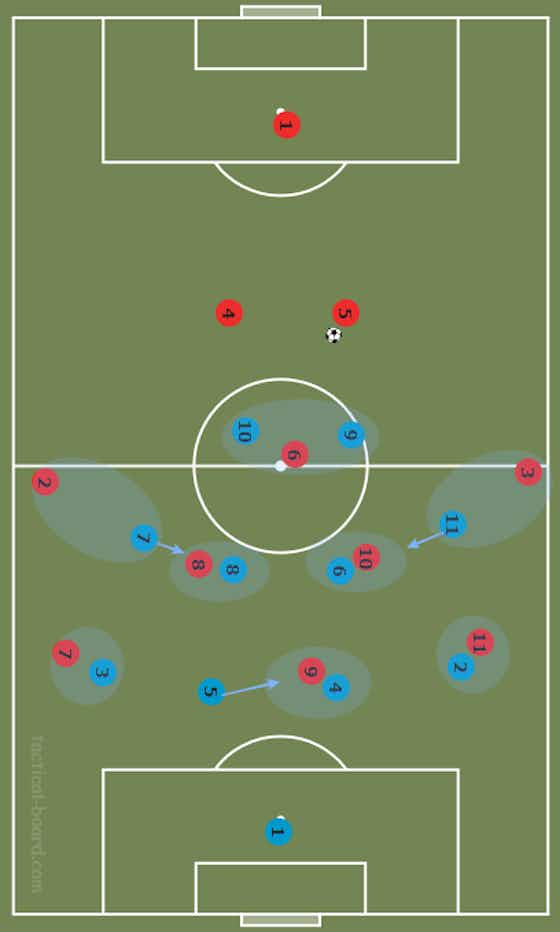
In the matches, this type of defending is rarely seen in the shown formation/setup, but in order to make it as clear as possible, this is how teams tend to orient themselves directly to the opponent. It is of the greatest importance for defenders to have an opposing player close to themselves, so they could have good access for a reaction if the ball is played towards “their” player. That is the parallel that this concept has with man coverage since the distances can’t be long and defenders tend to position themselves within the reach of the direct opponent.
The ball is now in the second plan, and the main attention is paid to the player inside the most valuable zones. It is common that all compact teams leave the flanks free for operation, which is mentioned earlier in the analysis, and the man-orientation isn’t the exception since the spaces next to the sidelines are the ones that have the longest distance from the goal when observing absolute values.
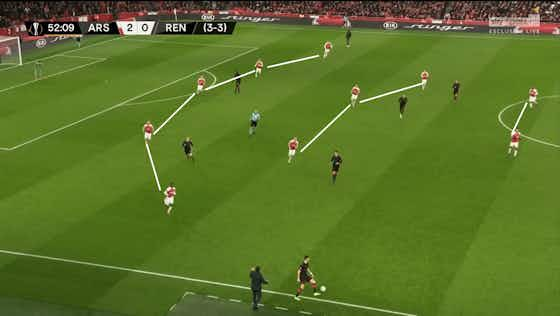
In last season’s UEFA Europa League campaign, Arsenal used the opponent-orientation to organise their defensive compactness in knockout stage duels against Rennes. We can see that all the attackers that are positioned in “worthy” areas have a player right on their backs so they aren’t that good of options for potential passes. Unai Emery’s team is well-organised down both axes and has good access to the players in reach if the pass is played in the guarded part of the field. In spite of everything said, it is clear that exploitation of (in)compactness depends on the motions of attackers, but compact teams are way tougher to break.
One thing that surely characterizes all the types of compactness, and why it is so important to be engaged, is the supportive angle of it. In opponent-orientation shapes, it is as essential as in all the others and results with the constant creation of 2 v 1 defensive surpluses over the players inside the block.
Although it is not that frequently seen in the game that teams orient their structures only on the opposition, the individual lines of the team often times base their compactness on the closest rival. Mostly due to the bad vertical organisation of the in possession team, defenders habitually have to man-mark the front line of the opposition since the attackers position themselves in a horizontal way against the defensive line.
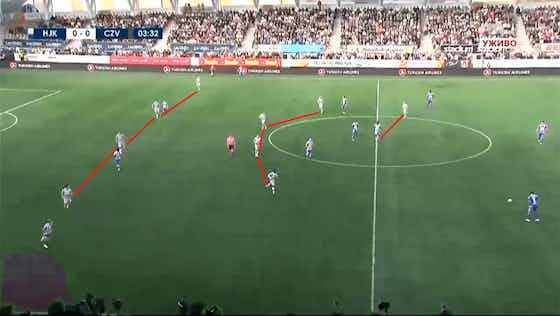
Another example from Red Star’s qualifications journey towards this season’s UCL group stage comes from their game against HJK. Their team is compact both horizontally and vertically, but the type of orientation distinct in different areas of action. The attacking line and midfield line are engaged with option-oriented movements, trying to disable opponents get the ball to the midfielders, whilst the defensive line is all about man coverage because of the poor positioning of Helsinki’s attackers.
Opponent-orientation is more often used by the teams playing man-marking, and even though that isn’t that common in modern football it is used in individual setups where one side tends to close down the player that is individually the biggest threat from the rival team. That can lead teams to lean towards the whole structure being oriented to opponents, with a huge impact on their compactness. Communication is the key factor in these scenarios and it needs to be perfected so the man-oriented compactness can succeed.
The third reference point for teams when defending is the space, and the spatial coverage is one of the most used gameplans in today’s out-of-possession game. The zonal marking is a whole other topic and can be explained deeply in a piece for itself, but the basic idea of it is that each player is in charge of the restricted area of the pitch. So what does compactness have to do with it?
It is quite simple, foundations of compactness require the existence of sustainable connections between teammates in an optimal distance, so they could control the room around themselves more easily, both individually and as a group. The compact defences are oftentimes focused on zonal protection and the idea od more and less valuable areas stems out of the space-control ground compactness has in its basics.
The main principle of space-orientation in compact defence organisation is the matter of controlling the restricted areas while keeping the shape of your block. Every player in the team has his own zone of operation and needs to establish authority inside it whilst still securing the quality of bonds he has with his other teammates.
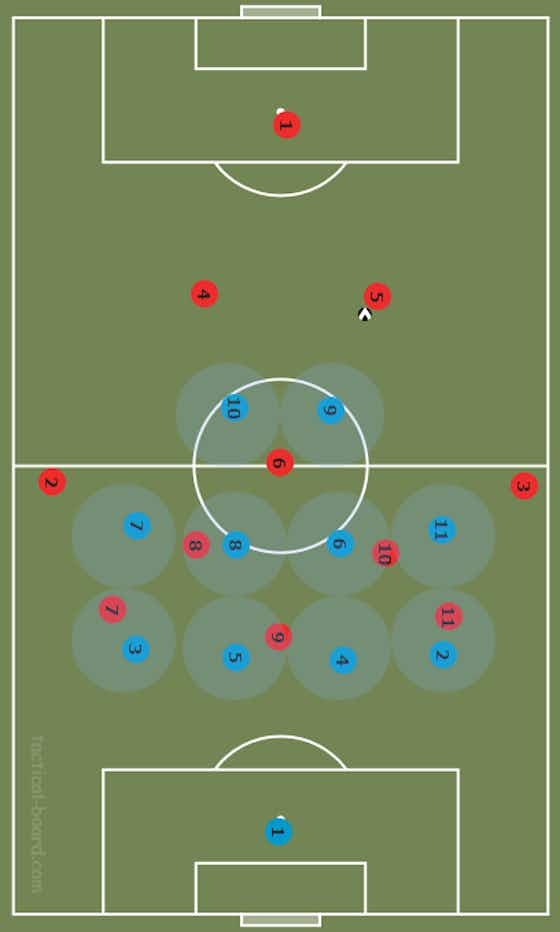
Here we can see the rough scheme of zonal defending of the team that is compact down both axes. The distances amongst the Blues can vary depending on the situation on the pitch, and what is important for them is to always maintain strong bonds so they could have an appropriate amount of access to all the reference points. Focusing on one reference point doesn’t mean that the others need to be overseen and neglected!
Zonal/space-oriented compactness is most usually aimed at protecting the most dangerous areas of the field. That brings us back to more and less worthy spaces since the central and inner corridors are most commonly pointed out as areas with the biggest value, the most-seen patterns of compact defending lean towards closing down these exact areas and leaving the flanks free.
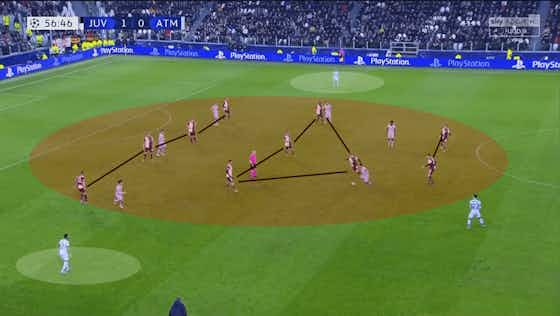
The shown image from this season’s Juventus versus Atlético Madrid game is a great example of space-oriented compactness. The first thing this type of defence secures for the out of possession team is the fact that they have numerical superiority in the most vulnerable zone of the pitch against the opposition. In the higher zones, they are basically set in a 6 v 3 shape (observing midfield four plus the two strikers against Atléti’s midfielders), and in the low one, they have a 4 v 3 matchup with their defenders against three forwards of the opposing team.
That enables them to press easier in those zones since all the players from the first matchup surely have the second teammate in support so they could easily go and double team the player getting/carrying the ball. They are greatly composed vertically, forcing the rivals to exit the concentrated area and making them go to the flanks, from where comes a lot less dangerous for their goal.
Even though spaces next to the sidelines are open, Juve is in well-organised shape from which they can easily direct themselves towards one attacking wing or another. The fact that the distance between the furthest players on both horizontal and vertical axis means that Bianconerri don’t cover a lot of space, but they control the whole red-marked area of the pitch and also opponents’ close-future moves.
Compactness isolated means that teams need to cover perfectly a part of the pitch that’s not that big, but the one big enough that will give them access to a variety of other areas which they don’t have in control at the exact moment. Compact setups open up the possibility of reacting and forcing rivals “dance” your way. By sitting tight in the central areas, the opponent is forced to move to the flanks, and these passes/movements can time and again be used as pressing triggers or for setting the pressing traps on the flanks.
The other important thing that comes out of small area coverage is the idea of the quality of control. If the team is occupying wider and longer area, while still being compact in some way (maintaining horizontal and vertical links) they will cover a bigger area of action but with less quality. They are at risk of lacking support coming from teammates, opponent exploiting gaps between the lines, providing them with forwarding options, and so on.
Juventus’ density of the block sure means that they cover the smaller area but they’ve established full control under that part of the pitch leaving the opposition in the unenviable situation. That means that compactness and distances are seen in somewhat of a counter-proportion – the bigger the distances between the players, compactness can still be talked about, but the quality of control is lesser – the lesser they are, the quality of control grows.
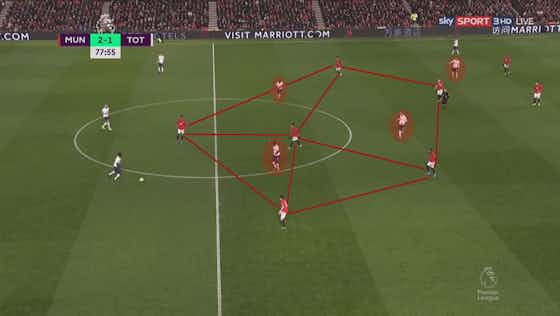
In Manchester United’s game against Tottenham this season, the hosts based their compactness on space coverage and that lead them to win the match. Their defensive line was about ten meters away from the defensive midfielder, and less than 25 metres away from the striker which secured good vertical compactness for them. The fact that the visitors have played a narrow attacking game benefited their 4-1-2-1-2 block since they had fewer difficulties in setting up both horizontal compactness and a vertical one.
As we can see, their main idea wasn’t to guard players nor options directly, but they engaged players with the exact space of operation whilst keeping strong bonds between each other. Good positioning in spatial protection “caged” the attackers and restricted their room for manoeuvring. The triangles and rectangle created with good zonal compactness meant from the supportive angle of defending, as every attacker had numerical inferiority against defenders around himself.
In these areas, defenders can press more easily counting on the side support they have from their teammates, so they have great access to ball/opponent/options even though they are primarily focused on the reference point of space. The part of the pitch they cover is once again small in terms of the environment, but the quality of control they have over it is on a very high level.
The option-orientation is probably the most complex focal point for teams that lean towards compactness since it is a mixture of all of the above three reference points. It requires a great amount of game understanding and moving in order to anticipate and disrupt opposition’s future plans.
That being the fact, it is clear why it is commonly seen as the space-orientation, because teams who try to move in a way of defending possible options must also defend spaces through which the ball should be played. The ball-orientation aspect is the initial one when talking about option-closure. The first players of the block that is oriented towards closing progress options are the ones who focus themselves to the player with the ball. Opponent-orientation is included in this concept in higher stages of the field, where the attackers are more static and/or defenders have tasks to close-guard them.

The “rough scheme” of option orienting looks like this, and I tried to point out the option coverage in the simplest possible way, without direct man-marking. When covering options, players often use shadow defending to close down the potential passing lanes towards the players operating behind them.
The other focal point of option-oriented compactness is communication. This concept is based upon constant motions, understanding of the game and planed movements that will force the opposition to enter the traps. It is particularly more difficult to create compact structures that look nice on sight all the time, but it is commonly manageable to create compact blocks that are applicable in reality.
Compactness in option-oriented setups doesn’t need to look beautiful in order to be successful but needs to be based on the foundations of close-distancing and high-level control in the areas that team is trying to protect. Players from one side often don’t keep “the line” when covering options but keep their compactness because they have strong links to their teammates which allow them access to opponents and the ball, along with the fact that they are in charge of some restricted area in the field.
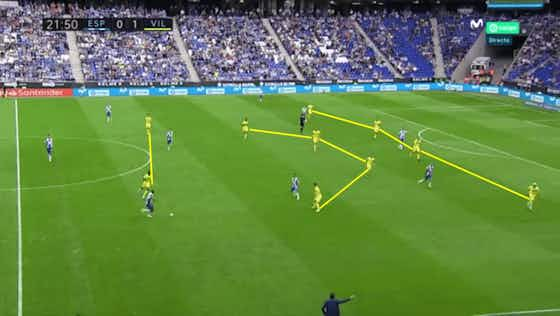
The situation from Espanyol versus Villarreal game shows us how option-oriented teams don’t need to be horizontally or vertically strict in order to be successful. We can see how Karl Toko Ekambi directs his run towards the ball carrier while at the same time uses his shadow to defend two players in the central corridor (that is possible because of the body angle of the player with the ball and his own body position). The other striker moves inside to enable himself with access for a reaction if the ball is played towards the midfielder while keeping appropriate distance to the far-side defender.
Midfielders of Villarreal are the ones especially focused on option covering since the left midfielder of the four (Moi Gómez) has a double role – closing down the passing lane towards the player between the lines in the half-space and reacting on the potential pass to direct rival on his right-hand side. The furthest midfielder (André-Frank Zambo Anguissa) moves himself inwards in order to cut down the potential passing lane towards the winger next to his own right full-back, whilst two central midfielders (Vicente Iborra and Santi Cazorla) are providing defenders with support and providing correction to Gómez.
This setup of the defending team results with ball carrier entering the set pressing trap by moving forward down the half-space. His progress solutions are shut down and he’s able just to prolong the decision-making which can ultimately result with turnover in possession. Even though Villarreal doesn’t look “playbook compact”, their compactness is seen in practice as they maintain control among the area they defend and leave ball carrier with no real options.
The teams that try to defend this way are the ones combining anticipation and space control, covering the spaces that are mostly occupied and the ones that can be “used against them”. Compactness hugely influences the option-oriented defences as it helps them be more “secure” while defending since the sustainable distances between one team’s teammates guarantee them defensive support. Correction and defensive surpluses are both possible due to compactness of connections players maintain.
That mostly eliminates the individual factor of defending, leaving less chance for the opposition to get better of the direct guard if he has a qualitative advantage over him. The support that comes from compactness sets player that is initially in subordinate position into numerical superior set up his teammate and him create against the opponent, so quality is compensated with quantity.
As I said, option-defending is almost exclusively related to other types of focus-defending and different lines of the team behave differently, depending on the situation on the field. The main thing for them is to use their sense for the game in order to close all the progressive options possible, and it is quite important that they manage to combine option-closure with zonal coverage, which can be essential for them in order to protect spaces through which passing lanes are leading.
Although there is even a lot more to be written on defensive compactness, that will be furthermore examined in the next part of this tactical theory analysis series. Compactness is the foundation of good defending in today’s football and, as I mentioned many times, it depends on strong bonds between the players who are on optimal distances from each other. Playing along this concept in the defence can secure one team to have access to react, a great amount of support and correction and to the possibility to neutralise teams/individuals by controlling the space/opposition.
In volume two of this tactical analysis, we’ll talk about how compactness influences attacking tactics of different teams and how it interferes transition phases of the game. Also, I’ll try to add something more to the relation between this concept and defending, since there is a lot left out which needs to be explained as troubles of incompact defending and pointing out the importance of defensive access.







































